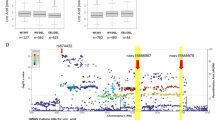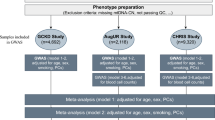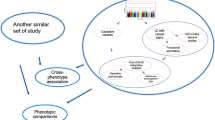Abstract
Extended homozygosity is a genomic region in which the copies inherited from parents are identical, and has obvious inter-individual differences in length and frequency. Runs of homozygosity (ROHs), regarded as a type of structure variations, may have potential capacity in regulating gene transcription. To learn more about the genome-wide distribution of ROH regions in humans and understand the potential roles, this study applied ROH-based approach to quantify and characterize ROHs in 41 Chinese Han female subjects, and test potential associations between ROHs and mRNA expressions by eQTL analysis to ascertain whether ROHs are relevant to gene transcription in peripheral blood mononuclear cells (PBMCs). 10,884 ROH regions were identified in human genome. The average cumulative length of ROH regions was 217,250 ± 20,241 kb. The number of core segments in each chromosome generally matched the total length of corresponding chromosome, i.e., the longer the chromosome, the more the core segments. Genes located in the core regions of ROH were significantly enriched in multiple basic metabolism pathways. A total of 226 cis-eQTLs and 178 trans-eQTLs were identified. The cis-effect size was mainly concentrated at ± 0.5; and the trans-effect size was mainly concentrated at −1.5 and 1.0. Genes with eQTL effects were significantly enriched in functions related to protein binding, cytosol, nucleoplasm, nuclear membrane, protein binding and citrate metabolic process. This study described comprehensive distributions and characteristics of ROH in Han female Chinese, and recognized the significant role of ROH associated with gene transcription in human PBMC.




Similar content being viewed by others
References
Albert FW, Kruglyak L (2015) The role of regulatory variation in complex traits and disease. Nat Rev Genet 16:197–212
Balmain A (2002) Cancer: new-age tumour suppressors. Nature 417:235–237
Campbell H, Carothers AD, Rudan I, Hayward C, Biloglav Z, Barac L, Pericic M, Janicijevic B, Smolej-Narancic N, Polasek O, Kolcic I, Weber JL, Hastie ND, Rudan P, Wright AF (2007) Effects of genome-wide heterozygosity on a range of biomedically relevant human quantitative traits. Hum Mol Genet 16:233–241
Di Pietro F, Ortenzi F, Tilio M, Concetti F, Napolioni V (2011) Genomic DNA extraction from whole blood stored from 15- to 30-years at −20 degrees C by rapid phenol-chloroform protocol: a useful tool for genetic epidemiology studies. Mol Cell Probes 25:44–48
El-Shanti H, Lidral AC, Jarrah N, Druhan L, Ajlouni K (2000) Homozygosity mapping identifies an additional locus for Wolfram syndrome on chromosome 4q. Am J Hum Genet 66:1229–1236
Gibson J, Morton NE, Collins A (2006) Extended tracts of homozygosity in outbred human populations. Hum Mol Genet 15:789–795
Heinig M, Petretto E, Wallace C, Bottolo L, Rotival M, Lu H, Li Y, Sarwar R, Langley SR, Bauerfeind A, Hummel O, Lee YA, Paskas S, Rintisch C, Saar K, Cooper J, Buchan R, Gray EE, Cyster JG, Cardiogenics C, Erdmann J, Hengstenberg C, Maouche S, Ouwehand WH, Rice CM, Samani NJ, Schunkert H, Goodall AH, Schulz H, Roider HG, Vingron M, Blankenberg S, Munzel T, Zeller T, Szymczak S, Ziegler A, Tiret L, Smyth DJ, Pravenec M, Aitman TJ, Cambien F, Clayton D, Todd JA, Hubner N, Cook SA (2010) A trans-acting locus regulates an anti-viral expression network and type 1 diabetes risk. Nature 467:460–464
Huang DW, Sherman BT, Lempicki RA (2009) Systematic and integrative analysis of large gene lists using DAVID bioinformatics resources. Nat Protoc 4:44–57
Ismail J, Jafar TH, Jafary FH, White F, Faruqui AM, Chaturvedi N (2004) Risk factors for non-fatal myocardial infarction in young South Asian adults. Heart 90:259–263
Keller MC, Visscher PM, Goddard ME (2011) Quantification of inbreeding due to distant ancestors and its detection using dense single nucleotide polymorphism data. Genetics 189:237–U920
Lencz T, Lambert C, DeRosse P, Burdick KE, Morgan TV, Kane JM, Kucherlapati R, Malhotra AK (2007) Runs of homozygosity reveal highly penetrant recessive loci in schizophrenia. Proc Natl Acad Sci USA 104:19942–19947
Lin PI, Kuo PH, Chen CH, Wu JY, Gau SSF, Wu YY, Liu SK (2013) Runs of homozygosity associated with speech delay in autism in a Taiwanese Han population: evidence for the recessive model. PLoS One 8:e72056
Lin X, Deng FY, Mo XB, Wu LF, Lei SF (2015) Functional relevance for multiple sclerosis-associated genetic variants. Immunogenetics 67:7–14
McQuillan R, Leutenegger AL, Abdel-Rahman R, Franklin CS, Pericic M, Barac-Lauc L, Smolej-Narancic N, Janicijevic B, Polasek O, Tenesa A, Macleod AK, Farrington SM, Rudan P, Hayward C, Vitart V, Rudan I, Wild SH, Dunlop MG, Wright AF, Campbell H, Wilson JF (2008) Runs of homozygosity in European populations. Am J Hum Genet 83:359–372
Nalls MA, Simon-Sanchez J, Gibbs JR, Paisan-Ruiz C, Bras JT, Tanaka T, Matarin M, Scholz S, Weitz C, Harris TB, Ferrucci L, Hardy J, Singleton AB (2009) Measures of autozygosity in decline: globalization, urbanization, and its implications for medical genetics. PLoS Genet 5:e1000415
Nothnagel M, Lu TT, Kayser M, Krawczak M (2010) Genomic and geographic distribution of SNP-defined runs of homozygosity in Europeans. Hum Mol Genet 19:2927–2935
Ober C, Loisel DA, Gilad Y (2008) Sex-specific genetic architecture of human disease. Nat Rev Genet 9:911–922
Pemberton TJ, Absher D, Feldman MW, Myers RM, Rosenberg NA, Li JZ (2012) Genomic patterns of homozygosity in worldwide human populations. Am J Hum Genet 91:275–292
Pickrell JK, Marioni JC, Pai AA, Degner JF, Engelhardt BE, Nkadori E, Veyrieras JB, Stephens M, Gilad Y, Pritchard JK (2010) Understanding mechanisms underlying human gene expression variation with RNA sequencing. Nature 464:768–772
Rasio D, Negrini M, Manenti G, Dragani TA, Croce CM (1995) Loss of heterozygosity at chromosome 11q in lung adenocarcinoma: identification of three independent regions. Cancer Res 55:3988–3991
Sheffield VC, Carmi R, Kwitek-Black A, Rokhlina T, Nishimura D, Duyk GM, Elbedour K, Sunden SL, Stone EM (1994) Identification of a Bardet–Biedl syndrome locus on chromosome 3 and evaluation of an efficient approach to homozygosity mapping. Hum Mol Genet 3:1331–1335
Simon-Sanchez J, Scholz S, Fung HC, Matarin M, Hernandez D, Gibbs JR, Britton A, de Vrieze FW, Peckham E, Gwinn-Hardy K, Crawley A, Keen JC, Nash J, Borgaonkar D, Hardy J, Singleton A (2007) Genome-wide SNP assay reveals structural genomic variation, extended homozygosity and cell-line induced alterations in normal individuals. Hum Mol Genet 16:1–14
Taylor TD, Litt M, Kramer P, Pandolfo M, Angelini L, Nardocci N, Davis S, Pineda M, Hattori H, Flett PJ, Cilio MR, Bertini E, Hayflick SJ (1996) Homozygosity mapping of Hallervorden–Spatz syndrome to chromosome 20p12.3-p13. Nat Genet 14:479–481
Westra HJ, Peters MJ, Esko T, Yaghootkar H, Schurmann C, Kettunen J, Christiansen MW, Fairfax BP, Schramm K, Powell JE, Zhernakova A, Zhernakova DV, Veldink JH, Van den Berg LH, Karjalainen J, Withoff S, Uitterlinden AG, Hofman A, Rivadeneira F, ‘t Hoen PAC, Reinmaa E, Fischer K, Nelis M, Milani L, Melzer D, Ferrucci L, Singleton AB, Hernandez DG, Nalls MA, Homuth G, Nauck M, Radke D, Volker U, Perola M, Salomaa V, Brody J, Suchy-Dicey A, Gharib SA, Enquobahrie DA, Lumley T, Montgomery GW, Makino S, Prokisch H, Herder C, Roden M, Grallert H, Meitinger T, Strauch K, Li Y, Jansen RC, Visscher PM, Knight JC, Psaty BM, Ripatti S, Teumer A, Frayling TM, Metspalu A, van Meurs JBJ, Franke L (2013) Systematic identification of trans eQTLs as putative drivers of known disease associations. Nature Genetics 45:1238–1243
Author information
Authors and Affiliations
Corresponding authors
Ethics declarations
Funding
The study was supported by Natural Science Foundation of China (81502868, 81541068, 81473046, 31271336, 81373010, 31401079, and 81401343), the Natural Science Foundation of Jiangsu Province (BK20130300, BK20150346), the Natural Science Research Project of Jiangsu Provincial Higher Education (16KJA330001), the Startup Fund from Soochow University (Q413900112, Q413900712), and a Project of the Priority Academic Program Development of Jiangsu Higher Education Institutions.
Conflict of interest
None of the authors has any conflict of interest to disclose.
Ethical approval
All procedures performed in studies involving human participants were in accordance with the ethical standards of the institutional and/or national research committee and with the 1964 Helsinki declaration and its later amendments or comparable ethical standards. The study was approved by Institutional Research Ethic Board at the Soochow University. Informed consent was obtained from all individual participants included in the study.
Additional information
Communicated by S. Hohmann.
Electronic supplementary material
Below is the link to the electronic supplementary material.
Rights and permissions
About this article
Cite this article
Lu, YH., Wang, BH., Xia, W. et al. The distribution and functional relevance analysis of runs of homozygosity (ROHs) in Chinese Han female population. Mol Genet Genomics 293, 197–206 (2018). https://doi.org/10.1007/s00438-017-1378-1
Received:
Accepted:
Published:
Issue Date:
DOI: https://doi.org/10.1007/s00438-017-1378-1




